Potty Training and Daycare: A Parent’s How-To Guide

- Open communication between parents, caregivers, and teachers is key when potty training a child in daycare or preschool.
- Consistency in potty training routines between home and a daycare setting will lead to successful potty training.
- When parents and child care providers work as a team, potty training can be a positive experience for your child.
Potty training is an important milestone in your child’s development. For many parents, it can also seem like one of the toughest parenting challenges. And what if your child spends part of their time in preschool, daycare, or with other caregivers? How do you manage toilet training in different settings with different people?
The good news is that potty training can be positive and successful when parents, teachers, and caregivers work as a team. The keys to potty training at daycare are open communication, consistent routine, and preparing your child for the transition out of diapers.
Do Daycares Help With Potty Training?
The answer to this question depends on the daycare provider. When choosing a daycare or preschool, you should research whether they help with potty training. Some preschools may require that your child be potty trained and accident-free before attending. If that’s the case, you should start potty training well before your child’s first day.
Daycares that look after a broader age range of children or federally funded daycares like Head Start do not require children to be potty trained. The daycare environment can be a great place to potty train because having other children in the classroom who are also toilet training can be very encouraging to a toddler. The teachers are also experienced and will be able to support your child.
How Do You Potty Train a Child in Daycare?
When there is more than one caregiver involved in your child’s day, it’s essential to make sure that everyone is on the same page when it comes to potty training. There are a few key things to keep in mind when potty training a child who attends daycare.
- Talk with the daycare or preschool about their potty training routine
Does the preschool or daycare have a potty training policy? Do they have a “no commando” rule? What’s the potty schedule during the day? Do all the children go together at set times, or is each child accompanied when they need to go? Do potty training children wear underwear during the day or do they stay in a diaper?
These are all important questions to ask your childcare provider early on before you begin potty training so that you and your child are aware of the expectations in the care setting. In addition, you may want to ask about the set-up of the bathroom, the height of the toilets and sinks, whether the children use adult or child-sized toilets, and how potty training is handled at nap time when accidents are more likely. The answers to these questions will help you talk with your toddler to prepare them for this transition.
- Talk with your toddler about potty training at daycare
Once you understand how the daycare runs its potty training routine, you can explain it to your toddler. Talk with them often about what will be expected of them. Tell them where the potties are in the daycare center or school. Make sure they know which teacher or caregiver they can ask if they need to use the toilet. Help them practice what to say.
Accidents are inevitable in potty training. So let your child know that they may happen. Explain how accidents will be handled at school and that your child doesn’t have to feel nervous or upset about them.
- Stay consistent
Once your child is in the swing of potty training at school, make sure to stick to their preschool or daycare routines as much as possible at home. Having different routines at school and home can be confusing at a time when toddlers are already trying to learn this important life skill.
For example, if they use adult toilets with potty seat inserts at daycare, do the same at home. If they always go to the bathroom after meals and before naps at preschool, try to maintain that schedule at home, too. If the daycare prefers potty training children in underwear rather than pull-ups, consider doing the same at home. This will make the potty training process easier for your child and get them out of diapers completely before you know it.
- Send your child in prepared
Remember that teachers and daycare providers are managing the potty training of many children at once. Sending your child to school prepared and appropriately dressed will make their teacher’s job much easier.
Pack a bag with spare undies, socks, and dry clothes in case of accidents. Dress your child in soft pants with elastic waistbands that they can pull on and off independently. Stick to simple clothes that can be changed easily if necessary.
- Communicate with caregivers often
When a child is potty training both at home and at daycare or school, communication between caregivers is key. Successful potty training happens when parents and caregivers work as a team to support their children.
Let the daycare know how potty training went overnight or over the weekend. Explain any new signs you have noticed your child giving when they need to pee. Alert the teachers to any concerns you have.
Also, ask the teachers how your child has coped at the end of every day and get their advice. Remember, they’ll have successfully potty trained many children and will have good tips.
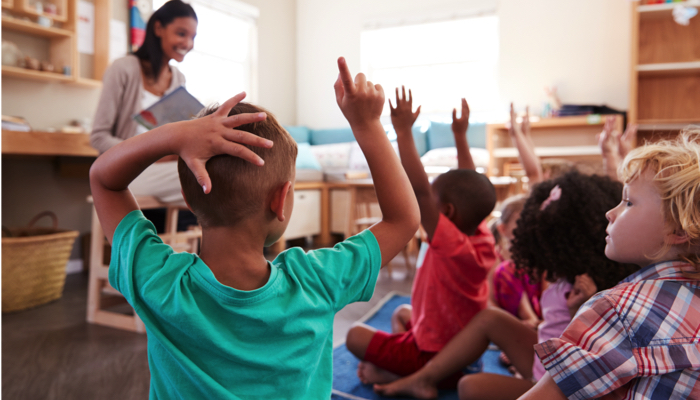
Does Your Child’s Daycare Have a Potty Training Policy?
One of the first things you should ask the director of a daycare or preschool that you’re considering is whether they have a potty training policy. This policy may include the center’s rules about staff members that assist children, the method of potty training used, and whether children will be in diapers, pull-ups, or underwear while training.
The policy may explain rules about using potty training reward charts or other incentives. It may also explain the protocol for sanitizing the toilet facilities your child will be using. The policy should also be clear about how the teacher will communicate with you about your child.
It’s important for you to understand the daycare center’s policy so that you and your child both know what’s expected and so that you can maintain consistency at home. You should also be familiar with the policy so that you can explain it to your child and make sure they are prepared for how things will work at the daycare.
What Age Do Daycares Require Potty Training?
Individual states differ in allowing preschools to require children to be potty trained at a specific age before enrolling. And different preschools and daycares may also have varying policies.
Many medical experts, like the National Institutes for Health and the UK’s National Health Service, agree that there’s no specific age that’s best for the start of potty training. It’s more effective to wait for a child to demonstrate signs of readiness to start the process. However, some preschools may require children age three and above to be potty trained before enrolling.
Daycare settings that take care of children from infancy through preschool age are less likely to have a potty training age requirement. In either case, ask about the provider’s policy before you enroll your child.
What if My Child is Potty trained At Home But Not At Daycare?
Consistency is an important part of the potty training process. If your child is doing well with going potty at home but not at daycare, you need to find out why they might be resistant. Are they just being a stubborn toddler who doesn’t want to potty train? Or are they feeling shy and anxious about the toilet outside of the home?
Ask your child to explain why they don’t want to use the toilet at school. Then, talk with the caregiver or teacher about your child’s behavior in the classroom and the toilet training routine. It may be that your child is overwhelmed by a group going to the bathroom together. Or, perhaps your child feels too embarrassed to ask the teacher when they need to go. Maybe your child feels anxious about having an accident at school, so they’re skipping using the potty altogether.
Your care provider can help by asking your child if they would like to use the potty rather than waiting for your child to tell them. They could allow your child to go to the bathroom by themselves rather than with the group. If you talk openly with your caregiver and work together, you’ll get to the bottom of your child’s resistance. Although it may be frustrating, try not to pressure your child, and be sure to give them plenty of time and patience.
FAQs
Can a daycare help potty train my special needs child?
There may be additional issues to consider when potty training a child with special needs in a daycare setting. However, clear communication with your care provider can help your child reach this milestone at their own pace.
Make sure to explain to the teachers any signs or signals that your child uses to refer to the potty. Ask them to help your child by practicing the steps involved in using the bathroom. If you use visual aids at home to help your child, bring one into the daycare for your caregivers to maintain consistency for your child.
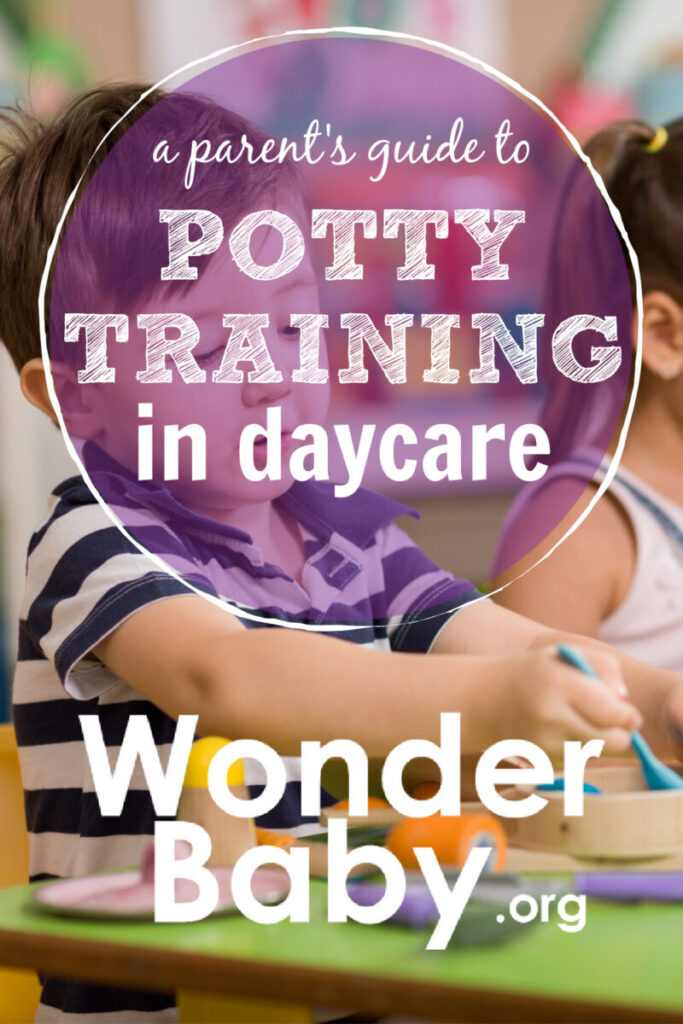
Related Posts
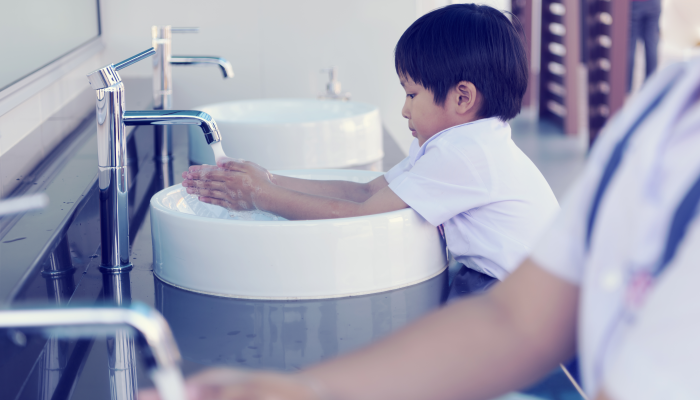
IEPs, Potty Training
7 Sample Toileting IEP Goals
Toileting IEP goals should address the specific needs and abilities of each child. Be flexible and patient as your child works on their toileting skills.
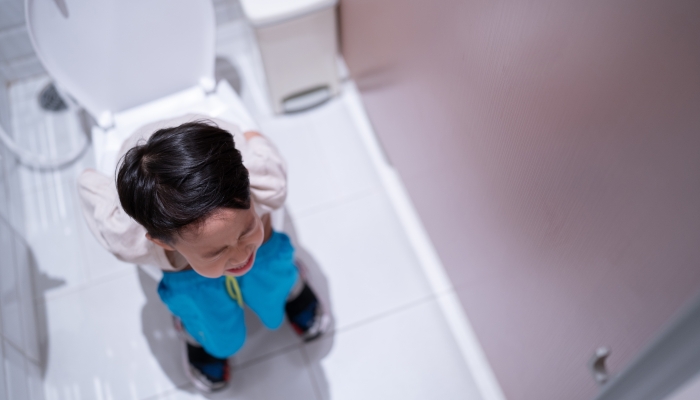
Potty Training
How To Deal With Constipation When Potty Training
Constipation is common amongst children of potty training age. Many children suffer from potty training constipation, but there are things you can do to help.
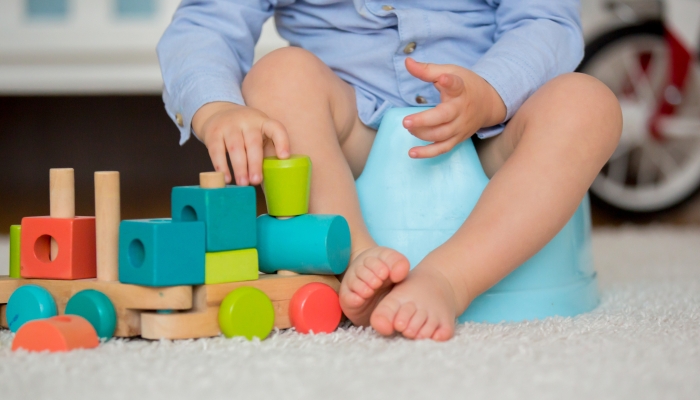
Potty Training
5 Potty Training Games To Make Potty Training Fun
Learning to use the toilet doesn’t have to feel like hard work. There are lots of potty training games you can play with your toddler to make learning fun.